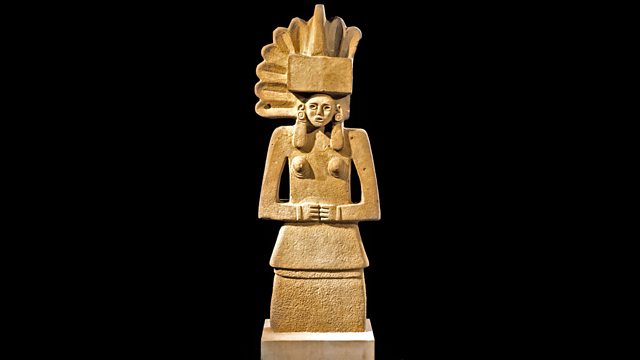Statue of Huastec goddess
This week Neil MacGregor is meeting the gods. Today he is in Mexico, with the sculpture of a goddess made by the Huastec people of Mexico associated with sexuality and fertility.
The history of humanity as told through one hundred objects from the British Museum in London is in Mexico. This week Neil MacGregor is meeting the Gods - exploring the sophistication of religious art in the 14th and 15th centuries as people around the world created physical expressions for devotion and for representing the divine.
Today he is with a striking sandstone sculpture of a goddess made by the Huastec people of present day Mexico. This remarkable figure stands bare breasted with hands folded over her stomach and wearing a remarkable fan-shaped headdress. She has been associated with the later Aztec goddess of sexuality and fertility.
The writer Marina Warner describes the power of the goddess figure in matters of fertility and sexuality while the art historian Kim Richter describes the particular nature of Huastec society and sculpture.
Producer: Anthony Denselow
Last on
![]()
Discover more programmes from A History of the World in 100 Objects about religion
About this object
Location: Mexico
Culture: Aztec, Maya and Central America
Period: AD 900-1521
Material: Stone
��
This statue was made by the Huastecs, a people conquered by the Aztecs in about 1450. Goddess statues like this were erected throughout Huastec territory and were the main focus of their religion. Making statues of the gods was thought to be dangerous. Sculptors feared they or their families might die as a result, so they fasted and performed prayers and rituals before they began. The Aztecs identified the Huastec mother-goddess with their own goddess of fertility and sexuality, Tlazolteotl, and the two figures in some ways merged.
What was the Aztec attitude to sin?
Tlazolteotl was the goddess of filth worshipped throughout Mesoamerica. She was a goddess of sexuality and fertility who would devour excrement and sin and transform it into renewed vitality. Sex was highly regulated in Aztec society and sexual transgressions heavily punished. Some sexual misdemeanours were confessed to a priest of Tlazolteotl and were forgiven if the penitent worshipper underwent an appropriate penance. Usually they would shed their own blood as part of this, piercing their tongue, ears or penis with a stingray spine.
Did you know?
- Statues of the Huastec goddess continued to be venerated into the 19th century, being identified with the Virgin Mary.
The power to guarantee continuity
By Marina Warner, historian and broadcaster
��
Well it’s quite remarkable because at first it looks as if it might not be that interesting, and then it draws you in, and I think one of the reasons that you are drawn in is the expression: it’s very powerful, with staring eyes. And some remains, perhaps, of paint or perhaps the socket in which some stone was once embedded: and so she has actually quite a vivid staring look and her mouth is open too.
Her ears are quite widely spread so that they can hold these very large ear spools; that’s a very characteristic decoration or ornament for the Mesoamerican grand dignitary or goddess; a sort of sign of power, probably gold. Her hair is braided and hangs in very pendulous sort of tassels on her shoulders, and her breasts actually pick up this look of her eyes; they are in fact themselves rather like eyes.
And then as you begin to look more closely, at this arresting, sort of staring presence, you realise that under her breasts there are some marks, and these are the marks that she has given birth. They’re meant to indicate – the breasts themselves are not pendulous, but as I say they stare out at you like eyes – but underneath them there are folds of flesh, and that is the sign that she is a mother who has possibly given birth more than once: these are breasts that have been used.
And then her hands are exactly symmetrical: not clasped, but resting on where her womb would be. And again that draws attention to the fact that she is fecund. Fecund and has been fecund and is there as a power to guarantee the continuity of the people who worship her, of the tribe, and of vitality itself: of the life principle itself.
Transcript
Broadcasts
- Thu 8 Jul 2010 09:45����ý Radio 4 FM
- Thu 8 Jul 2010 19:45����ý Radio 4 FM
- Fri 9 Jul 2010 00:30����ý Radio 4
- Thu 15 Jul 2021 13:45����ý Radio 4
Featured in...
![]()
Religion—A History of the World in 100 Objects
A History of the World in 100 Objects - objects related to religion.
Podcast
-
![]()
A History of the World in 100 Objects
Director of the British Museum, Neil MacGregor, retells humanity's history through objects





